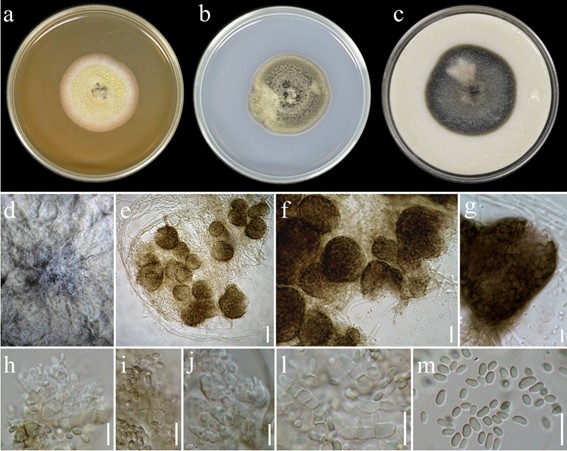Caatingomyces brasiliensis T.G.L. Oliveira, C.M. Souza- Motta, O.M.C. Magalha˜es & J.D.P. Bezerra,
MycoBank number: MB 827889; Index Fungorum number: IF827889;Facesoffungi number: FoF05817; Fig. 2
Etymology: Named after its occurrence in Brazil.
Holotype: URM 91831
Endophyte of branches of Poincianella pyramidalis. Sexual morph Undetermined. Asexual morph Mycelium superficial or immersed, hyaline to medium brown, septate, branched, hyphae thin-walled, broad and darker when linked to the conidiomata. Conidiomata pycnidial (28.6–) 31.2–52 (–67.6) 9 (23.4–) 26–31.2 (– 52) lm, superficial or immersed in the culture medium, isolated or clustered, globose to subovoid, medium brown when young and dark at maturity, pseudoparenchymatous, glabrous, thin-walled. Rostrate ostiole absent or poorly developed, conidia released by irregular rupture. Conidiogenous cells (3–) 3.5–5 (–6.5) 9 (3–) 4–5.5 lm, phialidic, slightly tapered and truncated at the apex with robust base, sometimes branched, hyaline to medium brown, arising from the internal cells of the pycnidial wall. Conidia (3.2–) 4.2–5.3 9 2.1 lm, hyaline, aseptate, ellipsoid, apex obtuse with truncated base, smooth and thin-walled.
Culture characteristics: Colonies reaching 3 to 3.5 cm in diameter after 15 days at 25 °C in the dark. On OA spreading, erumpent, aerial mycelium sparse with smooth margins; surface grey-olivaceous to white, reverse black. On PDA spreading, erumpent, aerial mycelium sparse with smooth and uneven margins; surface yellowish-brown to pale brown with the presence of yellowish exudate, reverse pale brown centre to black at the extremities. On MEA spreading, initially creamy, erumpent, surface yellowish-whitish with smooth margins and presence of exudate, reverse beige.
Material examined: BRAZIL, Para´ıba State, Santa Teresinha municipally, Tamandua´ farm, 07°1.524S, 037°23.518 W, an endophyte from branches of Poincianella pyramidalis (Fabaceae), May 2013, J.D.P. Bezerra (URM 91831, holotype), ex-type living culture (URM 7916); as endophyte from branches of Poincianella pyramidalis (Fabaceae), May 2013, J.D.P. Bezerra, living culture (URM 7917).
GenBank numbers: ITS: MH929437, MH929438, LSU: MH929439, MH929440, RPB2: MH929441, MH929442, TEF1-a: MH929443, MH929444.
Notes: Maximum likelihood analysis using the alignment of LSU rDNA sequences as presented by Quaedvlieg et al. (2014), demonstrated relationships of the new genus with Readeriella Syd. & P. Syd. in Teratosphaeriaceae (data not shown). In the phylogenetic analyses (Fig. 3) using combined LSU and ITS sequence data of Teratosphaeriaceae, the new genus Caatingomyces is related to Readeriella species but was placed in a distinct clade with high support. The TEF1-a and RPB2 sequences of C. brasiliensis were not included in the combined analyses, but are available in GenBank for further verification of its relationships and placement in Teratosphaeriaceae and affiliated families.
Caatingomyces brasiliensis mainly differs from Readeriella species that have a thick conidiomata wall, the presence of single and circular ostiole, by the shape of the conidiogenous cells producing three collarettes and deltoid, thick-walled and guttulate conidia with 3 lateral obtuse projections (Sutton 1980). Furthermore, Caatingomyces also differs from species of other genera in Teratosphaeriaceae, such as Parapenidiella Crous & Summerell which has conidia arranged in branched acropetal chains, pigmented ramoconidia, and erect and macronematous conidiophores (Crous et al. 2012); from Eupenidiella Quaedvl. & Crous by erect and solitary, terminally penicillate conidiophores and subcylindrical conidia arranged in branched chains and secondary conidia (Quaedvlieg et al. 2014).

Fig. 2 Caatingomyces brasiliensis (URM 91831, holotype). a Colony on MEA after 7 days. b Colony on PDA after 7 days. c Colony on AO after 7 days. d Detail of colony on PDA after 7 days. e Pycnidia. f Detail of pycnidia. g Detail of pycnidial wall. h–l Conidiogenous cells and conidia. m Conidia. Scale bars: e = 50 lm, f = 25 lm, g–m = 10 lm
